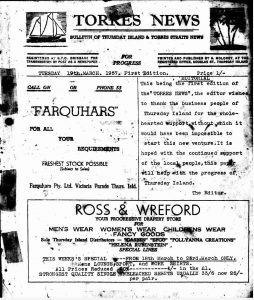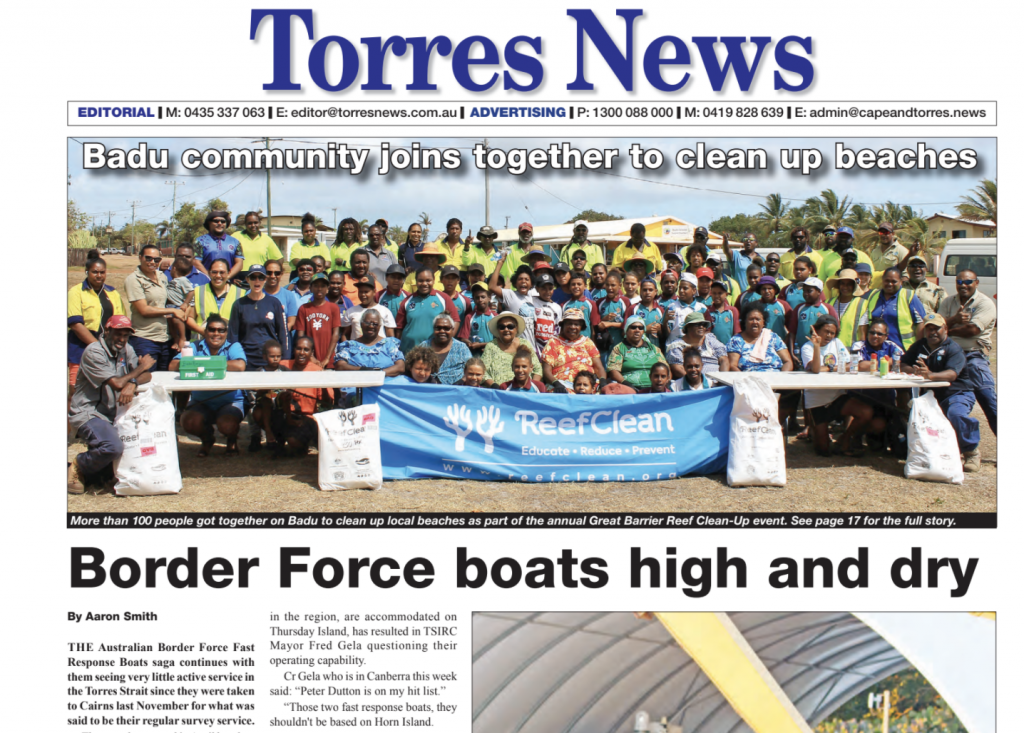When COVID-19 travel restrictions to the Torres Strait Islands started, Liberty Seekee’s daughters had to rush home to Horn Island, from their Brisbane boarding school.
But with remote communities in the Torres Strait at greater risk from COVID-19, the teenage girls had to self-isolate without family for two weeks before they could fly to their island home.
Stuck in Cairns, the teenagers were finding it hard to go without supplies like shampoo.
An unlikely hero stepped forth in the form of local federal MP Warren Entsch, who used his own time to buy, then deliver, necessities to the hotel for Liberty’s daughters and other Torres Strait Islander students in self-isolation.
That kind of good deed from the local MP would, in normal times, have prompted a story in the Torres Strait’s only local paper, the Cape and Torres News.
But in April, publisher and editor Corey Bousen had to make the difficult decision to suspend publication, leaving many stories like Liberty’s untold.
Corey said that with the cancellation of flights across Australia, he just didn’t have a way of getting a printed copy of the Torres Strait news from the mainland to the Torres Strait.
“The newspaper was printed in Townsville, trucked to Cairns overnight and then flown by varying different airlines to all corners of the distribution area,” Corey said.
“It actually became impossible to fly the newspaper anywhere.”
The situation could have been far worse. A week before the announced suspension, the Cape and Torres News was set to close for good.
Stop Press. RIP ‘Torres News’. Final edition of a mighty regional newspaper. Huge loss for #TorresStrait & #CapeYork. More here: https://t.co/6uUsa5Xayn #media #journalism #coronavirus #Covid_19 #Aboriginal #Indigenous #qldpol #auspol @aaronsmithtweet @electricnerve @gara_vee pic.twitter.com/5G4HaItXlQ
— Stefan Armbruster (@StefArmbruster) March 31, 2020
“My primary motivation in planning to wind up the business was to ensure the newspaper’s employees were paid their full entitlements before the newspaper became completely insolvent,” Corey said in a post on the paper’s Facebook page.
Luckily, the Australian Government announced the JobKeeper scheme, saving the paper’s staff.
“The announcement this week of the federal government’s Job Keeper payment is a terrific initiative that will allow the newspaper’s staff to continue earning a wage,” Corey said.
But JobKeeper hasn’t spelt the end of the paper’s troubles. Previous mergers and social media’s cannibalisation of readers were already contributing towards its decrease in circulation numbers.
Until late last year, the Cape and Torres News was actually two distinct local weeklies for two distinct communities: Cape News for mainland Cape York and Torres News for the Torres Strait Islands.
With circulation down from 3000 to 1500 copies a week, however, Corey had to make the difficult choice to merge two separate community’s local papers into one.
“Getting rid of the Torres News as its own standalone masthead was a big decision,” Corey said.
“I actually publish a Cape York News section inside and a Torres News section inside, so they still keep their own identity.”
“But it just enabled me to improve editorial content because I had a much bigger paper, and also double the circulation.”

The first edition of Torres News, Mar. 19, 1957. Torres News was merged with Cape News in October last year to create the Cape and Torres News (Trove)
Torres News had been its own paper since 1957.
When Torres Strait outsider Corey and his parents, Mark and Meg, bought Torres News in 2002, they made sure the paper remained the voice for the local community.
“It’s not our opinion that counts, it’s the local population’s opinion that counts,” Corey said.
“It was their platform, it was for the local Indigenous people, primarily, to have their issues voiced and focussed upon.”
Yet local MP Mr Entsch wasn’t happy with the merger.
“I personally think that was a mistake. Cape York is Cape York and Torres Strait is Torres Strait,” Entsch said.
Last year’s merger “really surprised” Liberty Seekee but he chose to see its bright side.
“At least we’ve got a more substantial paper,” Liberty said.
By merging, Corey had enough advertising revenue to continue telling local stories.
“Torres News is very important to a lot of people growing up, it’s their local paper,” Corey said.
“Even on the outer islands, people were always very excited if you showed up, to get their photo in the paper.”
The Torres Strait may have a population of only 4500 but with an area covering nearly 50,000 square kilometres, and a border with Papua New Guinea, its been the set of several prominent news stories.
From the Malu Sara boating disaster, a visit by then Prime Minister Tony Abbott – in which local media were initially refused entry to the media junket – and tombstone openings, Torres News has been there to cover news important to the local community and to wider Australia.
But these stories were told when the paper was at its peak financial health and could pay to fly editors in, covering accommodation and other expenses on top of their wages.

The Cape and Torres News covers stories of national importance. But with a lack of experienced journalists and lower distribution numbers, producing quality journalism has become more difficult (Supplied: the Cape and Torres News)
Corey thinks those days are long gone.
“You can’t continue to pay unlimited amounts for journalism. You have to cut corners and eventually quality suffers,” Corey said.
The way he sees it, one of the only ways to keep regional news alive would be the ABC, but even Aunty couldn’t create the same coverage as local papers could.
“I don’t think they’re going to pay to have a journalist based on Thursday Island,” Corey said.
None of the problems the Cape and Torres News has faced – their suspension, merger or difficulty in producing quality journalism due to revenue hits – should have been a surprise to anyone who’s witnessed the ongoing plight of scores of regional news outlets across Australia.
The Public Interest Journalism initiative has identified 156 newsrooms across the country that have had to close, decrease their number of publications, end their print edition or merge with other papers.
All over the country Australians are facing declining access to public interest journalism.
All over the country Australians are facing declining access to public interest journalism.
COVID-19 has turbo-charged closures, with News Corp suspending 60 of its community newspapers and Australian Community Media suspending 69.
Journalist Saffron Howden summarised the situation for Croakey.
“While public demand for journalism soars, the business of news has never been more precarious,” Saffron said.
“The advertising market is collapsing. And it’s hitting hardest where reliable, quality news is needed most – in rural communities.”
For Corey, he always knew the Cape and Torres News would close one day.
“I knew that the writing was on the wall for newspapers,” Corey said.
“Going back to even 2003, I knew that the internet would put us out of business one day.”
Even with this foresight, would he still have bought Torres News if he knew the actual challenges it would face?
“I’d absolutely do it again.”
FEATURED IMAGE: The Cape and Torres News has suspended publication due to flight and biosecurity restrictions brought on by COVID-19. The paper’s publisher hopes to resume printing once restrictions ease. (Pexel)



